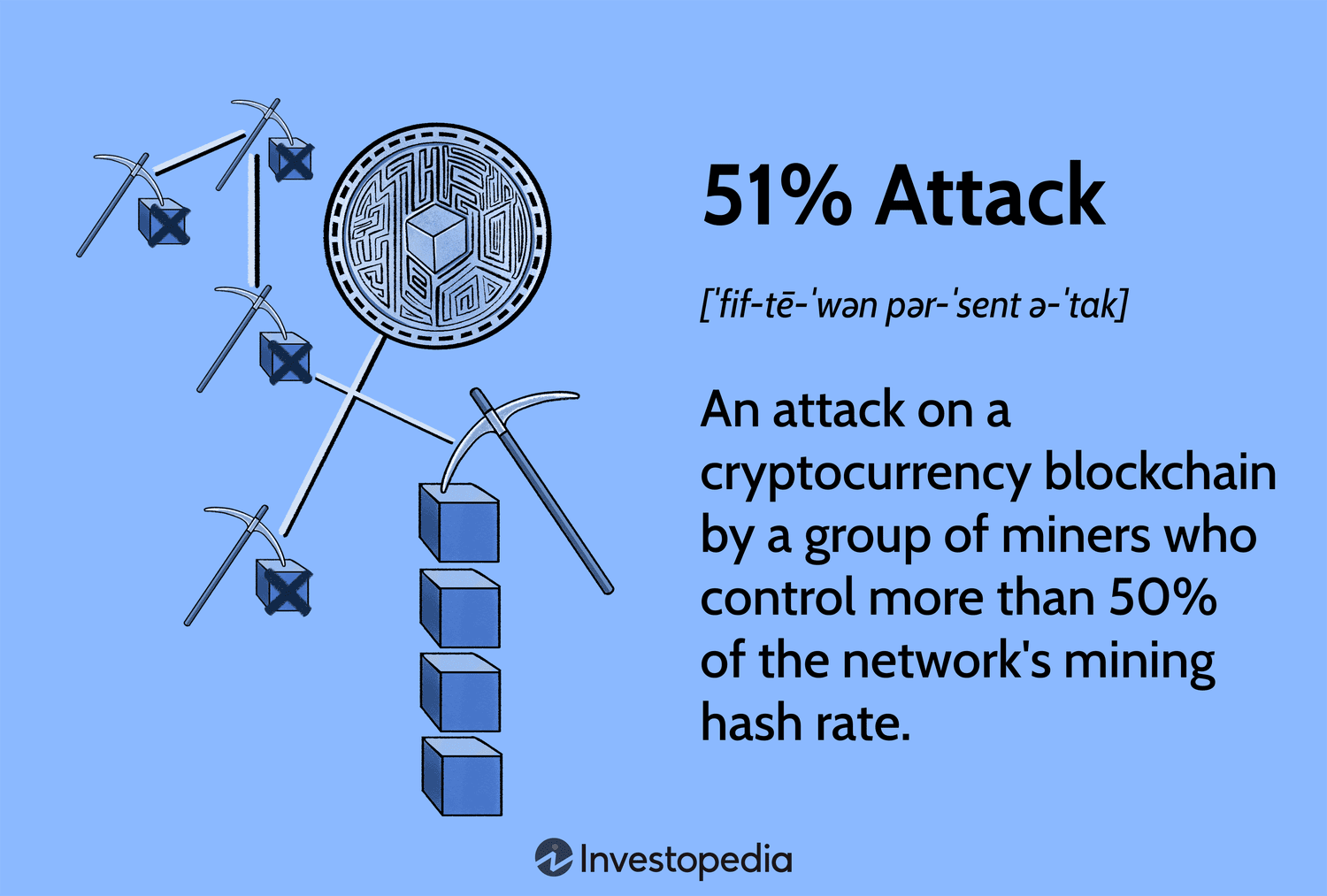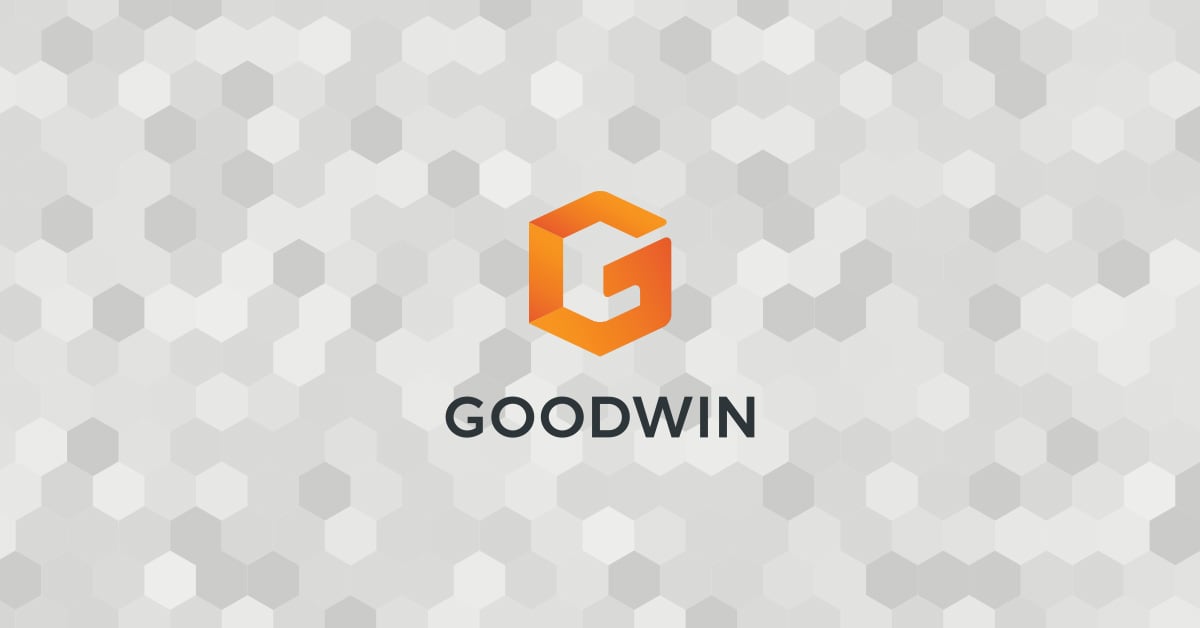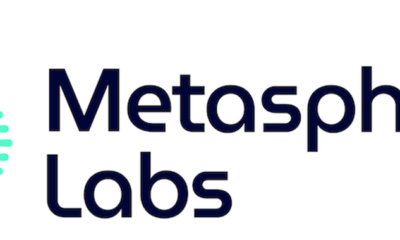News
Definition, who is at risk, example and cost

What is a 51% attack?
A 51% attack is an attack on the cryptocurrency blockchain by an entity or group that controls more than 50% of the network. If one party were to gain that much control over a network, they would have the power to alter the blockchain.
Attackers would be able to prevent new transactions from getting confirmations, allowing them to block payments between some or all users. They would also be able to cancel unconfirmed transactions completed while they were in control. Canceling transactions could allow them to double-spend coins, one of the problem mechanisms like proof of work that were created to prevent.
Key points
- Blockchains are distributed ledgers that record every transaction made on a cryptocurrency’s network.
- A 51% attack is an attack on a blockchain by an entity or group that controls more than 50% of the network.
- Attackers with majority control of the network can stop recording new blocks by preventing other miners from completing blocks.
- Changing historical blocks is impossible due to the chain of information stored in the Bitcoin blockchain.
- While a successful attack on Bitcoin or Ethereum is unlikely, smaller networks are frequent targets for 51% attacks.
Understanding a 51% attack.
A blockchain it is a distributed ledger, essentially a database, that records transactions and information about them. The blockchain network achieves majority consensus on transactions through a validation process. The blocks where the data is stored are sealed. Blocks are linked together via cryptographic techniques where information about previous blocks is recorded in each block. This makes it nearly impossible to change blocks once they have been confirmed enough times.
The 51% attack is an attack on the blockchain, in which one group controls more than 50% of the hashing (processing that solves the cryptographic puzzle) power of the network. This group then introduces an altered blockchain into the network at a very specific point on the blockchain, which is theoretically accepted by the network because the attackers would own most of it.
Changing historical blocks – transactions blocked before the attack began – would be extremely difficult even in the case of a 51% attack. The further back the transactions are, the more difficult it is to change them. It would be impossible to modify transactions before a checkpoint, where transactions become permanent in the Bitcoin blockchain.
Attacks are prohibitively expensive
A 51% attack is a very difficult and challenging task on a blockchain network with a high participation rate. In most cases, the attacker group should be able to control the necessary 51% and have created an alternative blockchain that they can insert at exactly the right time. Then, they would need to hash the core network. The cost of doing this is one of the most significant factors preventing a 51% attack.
For example, one of the most advanced application-specific integrated circuit (ASIC) miners is WhatsMiner M63S. Costs over $10,000 (new) and has a hash speed of 406 terahash per second (TH/s). A single or smaller group of miners would not be able to alter and mine the Bitcoin blockchain with just a few of these machines. It would take thousands of these ASICs to outperform the Bitcoin network. Smaller networks could be overcome using these mining rigs, but the benefits of doing so would not outweigh the costs of funding the attack and setting it up.
Hashing power rental services offer attackers lower costs because they only need to rent as much hashing power as they need for the duration of the attack.
After Ethereum went proof-of-stake, a 51% attack on the Ethereum blockchain became even more costly. To conduct this attack, a user or group would need to own 51% of the ETH staked on the network. It’s possible that someone could own that much ETH, but it’s unlikely.
According to Beaconchain, more than 32.3 million ETH were staked on May 8, 2024. An entity would need to own and stake more than 16.5 million ETH (more than $49 billion as of May 8, 2024) to attempt an attack.
Once the attack begins, the consensus mechanism would likely recognize it and immediately cut off the staked ETH, costing the attacker an extraordinary amount of money. Additionally, the community can vote to restore the “honest” chain, so an attacker would lose all their ETH only to have the damage repaired.
Attack timing
In addition to the costs, a group attempting to attack the network using a 51% attack must not only control 51% of the network but also introduce the altered blockchain at a specific time. Even if they own 51% of the network’s hashing rate, they still may not be able to keep up with the block creation rate or insert their own chain before new valid blocks are created by the “honest” blockchain network.
Again, this is possible on smaller cryptocurrency networks because there is less participation and lower hash rates. Large networks make it nearly impossible to introduce an altered blockchain.
Despite the name, you don’t need to have 51% of a network’s mining power to launch an attack. However, such an attack would have a lower chance of success.
Result of a successful attack
In case of a successful attack, attackers could block other users’ transactions or cancel them and spend the same cryptocurrency again. This vulnerability, known as double expense, is the digital equivalent of a perfect counterfeit. It is also the basic cryptographic obstacle that blockchain consensus mechanisms were designed to overcome.
The 51% successful attackers can also implement a Denial-of-Service (DoS) attack, where they block other miners’ addresses for the period they control the network. This prevents “honest” miners from regaining control of the network before the dishonest chain becomes permanent.
Who is at risk of the 51% attack?
The type of mining equipment is also a factor ASIC-secure mining networks are less vulnerable than those that can be mined with GPUs; they are much faster. Cloud services like NiceHash, which considers itself a “hash power broker,” theoretically allow you to launch a 51% attack using only rented hash power, especially against smaller, GPU-only networks.
Bitcoin Gold has been a common target for attackers because it is a smaller cryptocurrency in terms of hashrate. Since June 2019, the Michigan Institute for Technology’s Digital Currency Initiative has detected, observed, or been notified of more than 40 51% attacks—also called chain reorgs or reorgs—on Bitcoin Gold, Litecoin, and other smaller cryptocurrencies.
Are the chances of a 51% Bitcoin attack growing?
On May 8, 2024, the total hashrate of the Bitcoin network was 569.29 exahash per second (EH/s). The first three mining pools for three-day hashrate they were:
- FoundryUSA, at 175.76 EH/s; 30.9% of the total hashrate of the Bitcoin network
- AntPool, at 161.77 EH/s; 28.4% of the total hashrate of the Bitcoin network
- ViaBTC, at 73.11 EH/s; 12.8% of the total network hashrate
Together, these three pools made up 72.1% of the network’s hashrate, a whopping 486.9 EH/s (486.9 million TH/s – your computer’s CPU might be able to hash at around 15 kilo hashes per second). If Foundry and ViaBTC were to collude, they could take 51% of the hashrate (248 EH/s).
Foundry and Antpool together could control 69.3% of the network. Because these pools use platforms to connect pool members and manage workloads, if managers decided to take control they could issue work orders to their pools to work on the modified chain. Pool miners would have no idea which chain they are working on as their mining rigs automatically work on whatever task they are given.
Even more concerning is that these three pools also monopolize the majority of the network’s hash rates for Bitcoin Cash, Litecoin, and Bitcoin SV.
These pools have been operating for several years without problems, but the fact remains that they already control the majority of the hashing power of mineable and profitable cryptocurrencies.
What does a 51% attack do?
A 51% attack alters the blocks that are added to the blockchain, giving attackers the ability to create or modify transactions for the period they have control.
Has a 51% attack ever happened?
YES. Several blockchains have been attacked using this method, but they had small networks, were new, or had other vulnerabilities that made it possible.
How much would a 51% attack on BTC cost?
If a large mining pool were instructed by its managers to conduct an attack, it would not cost the managers much at the time of the attack. However, he would probably lose his honest miners once they found out. For a single person or group to conduct a 51% attack, they would need more than 304 EH/s of computing power. This is a huge cost considering that the fastest miner has a hash of 406 TH/s and costs more than $10,000 per unit (about 84,000 units).
The bottom line
A 51% attack is the unlikely event in which a group acquires more than 50% of a cryptocurrency network’s hashing power. These attacks happen on smaller crypto networks, but tend to fail on larger ones like Bitcoin because they are more secure.
The comments, opinions and analyzes expressed on Investopedia are for online information purposes. Read ours warranty and exclusion of liability for more information.
News
Terra Can’t Catch a Break as Blockchain Gets $6 Million Exploited

The attack, which exploited a vulnerability disclosed in April, drained around 60 million ASTRO tokens, sending the price plummeting.
The Terra blockchain has been exploited for over $6 million, forcing developers to take a momentary break the chain.
Beosin Cyber Security Company reported that the protocol lost 60 million ASTRO tokens, 3.5 million USDC, 500,000 USDT, and 2.7 BTC or $180,000.
Terra developers paused the chain on Wednesday morning to apply an emergency patch that would address the attack. Moments later, a 67% majority of validators upgraded their nodes and resumed block production.
The ASTRO token has plunged as much as 75%. It is now trading at $0.03, a 25% decline on the day. Traders who took advantage of the drop are now on 195%.
The vulnerability that took down the Cosmos-based blockchain was disclosed in April and involved the deployment of a malicious CosmWasm contract. It opened the door to attacks via what is called an “ibc-hooks callback timeout reentrancy vulnerability,” which is used to invoke contracts and enable cross-chain swaps.
Terra 2.0 also suffered a massive drop in total value locked (TVL) in April, shortly after the vulnerability was discovered. It plunged 80% to $6 million from $30 million in TVL and has since lost nearly half of that value, currently sitting at $3.9 million.
The current Earth chain emerged from the rubble as a hard fork after the original blockchain, now called Terra Classic, collapsed in 2022. Terra collapsed after its algorithmic stablecoin (UST) lost its peg, causing a run on deposits. More than $50 billion of UST’s market cap was wiped out in a matter of days.
Terraform Labs, the company behind the blockchain, has been slowly unravelling its legal woes since its mid-2022 crash. Founder Do Kwon awaits sentencing in Montenegro after he and his company were found liable for $40 billion in customer funds in early April.
On June 12, Terraform Labs settled with the SEC for $4.4 billion, for which the company will pay about $3.59 billion plus interest and a $420 million penalty. Meanwhile, Kwon will pay $204.3 million, including $110 million in restitution, interest and an $80 million penalty, a court filing showed.
News
Google and Coinbase Veterans Raise $5M to Build Icebreaker, Blockchain’s Answer to LinkedIn

Icebreaker: Think LinkedIn but on a Blockchain—announced Wednesday that it has secured $5 million in seed funding. CoinFund led the round, with participation from Accomplice, Anagram, and Legion Capital, among others.
The company, which is valued at $21 million, aims to become the world’s first open-source network for professional connections. Its co-founders, Dan Stone and Jack Dillé, come from Google AND Monetary base; Stone was a product manager at the cryptocurrency giant and also the co-creator of Google’s largest multi-identity measurement and marketing platform, while Dillé was a design manager for Google Working area.

The pair founded Icebreaker on the shared belief that the imprint of one’s digital identity (and reputation) should not be owned by a single entity, but rather publicly owned and accessible to all. Frustrated that platforms like LinkedIn To limit how we leverage our connections, Dillé told Fortune he hopes to remove paywalls and credits, which “force us to pay just to browse our network.” Using blockchain technology, Icebreaker lets users transfer their existing professional profile and network into a single, verified channel.
“Imagine clicking the login button and then seeing your entire network on LinkedIn, ChirpingFarcaster and email? Imagine how many introductions could be routed more effectively if you could see the full picture of how you’re connected to someone,” Stone told Fortune.
Users can instantly prove their credentials and provide verifiable endorsements for people in their network. The idea is to create an “open graph of reputation and identity,” according to the founders. They hope to challenge LinkedIn’s closed network that “secures data,” freeing users to search for candidates and opportunities wherever they are online. By building on-chain, the founders note, they will create a public ledger of shared context and trust.
Verified channels are now launched for
Chirping
Online Guide
Wallet
Discord
Telephone
TeleporterYou can find them in Account -> Linked Accounts Italian: https://t.co/mRDyuWW8O2
— Icebreaker (@icebreaker_xyz) April 3, 2024
“Digital networking is increasingly saturated with noise and AI-driven fake personas,” the founders said in a statement. For example: Dillé’s LinkedIn headline reads “CEO of Google,” a small piece of digital performance art to draw attention to unverifiable information on Web2 social networks that can leave both candidates and recruiters vulnerable to false claims.
“Icebreaker was created to enable professionals to seamlessly tap into their existing profiles and networks to surface exceptional people and opportunities, using recent advances in cryptographically verifiable identity,” the company said, adding that the new funding will go towards expanding its team and developing products.
“One of the next significant use cases for cryptocurrency is the development of fundamental social graphs for applications to leverage… We are proud to support Dan, Jack and their team in their mission to bring true professional identity ownership to everyone online,” said CoinFund CIO Alex Felix in a statement.
Learn more about all things cryptocurrency with short, easy-to-read flashcards. Click here to Fortune’s Crash Course in Cryptocurrency.
Fuente
News
Luxembourg proposes updates to blockchain laws | Insights and resources

On July 24, 2024, the Ministry of Finance proposed Blockchain Bill IVwhich will provide greater flexibility and legal certainty for issuers using Distributed Ledger Technology (DLT). The bill will update three of Luxembourg’s financial laws, the Law of 6 April 2013 on dematerialised securitiesTHE Law of 5 April 1993 on the financial sector and the Law of 23 December 1998 establishing a financial sector supervisory commissionThis bill includes the additional option of a supervisory agent role and the inclusion of equity securities in dematerialized form.
DLT and Luxembourg
DLT is increasingly used in the financial and fund management sector in Luxembourg, offering numerous benefits and transforming various aspects of the industry.
Here are some examples:
- Digital Bonds: Luxembourg has seen multiple digital bond issuances via DLT. For example, the European Investment Bank has issued bonds that are registered, transferred and stored via DLT processes. These bonds are governed by Luxembourg law and registered on proprietary DLT platforms.
- Fund Administration: DLT can streamline fund administration processes, offering new opportunities and efficiencies for intermediaries, and can do the following:
- Automate capital calls and distributions using smart contracts,
- Simplify audits and ensure reporting accuracy through transparent and immutable transaction records.
- Warranty Management: Luxembourg-based DLT platforms allow clients to swap ownership of baskets of securities between different collateral pools at precise times.
- Tokenization: DLT is used to tokenize various assets, including real estate and luxury goods, by representing them in a tokenized and fractionalized format on the blockchain. This process can improve the liquidity and accessibility of traditionally illiquid assets.
- Tokenization of investment funds: DLT is being explored for the tokenization of investment funds, which can streamline the supply chain, reduce costs, and enable faster transactions. DLT can automate various elements of the supply chain, reducing the need for reconciliations between entities such as custodians, administrators, and investment managers.
- Issuance, settlement and payment platforms:Market participants are developing trusted networks using DLT technology to serve as a single source of shared truth among participants in financial instrument investment ecosystems.
- Legal framework: Luxembourg has adapted its legal framework to accommodate DLT, recognising the validity and enforceability of DLT-based financial instruments. This includes the following:
- Allow the use of DLT for the issuance of dematerialized securities,
- Recognize DLT for the circulation of securities,
- Enabling financial collateral arrangements on DLT financial instruments.
- Regulatory compliance: DLT can improve transparency in fund share ownership and regulatory compliance, providing fund managers with new opportunities for liquidity management and operational efficiency.
- Financial inclusion: By leveraging DLT, Luxembourg aims to promote greater financial inclusion and participation, potentially creating a more diverse and resilient financial system.
- Governance and ethics:The implementation of DLT can promote higher standards of governance and ethics, contributing to a more sustainable and responsible financial sector.
Luxembourg’s approach to DLT in finance and fund management is characterised by a principle of technology neutrality, recognising that innovative processes and technologies can contribute to improving financial services. This is exemplified by its commitment to creating a compatible legal and regulatory framework.
Short story
Luxembourg has already enacted three major blockchain-related laws, often referred to as Blockchain I, II and III.
Blockchain Law I (2019): This law, passed on March 1, 2019, was one of the first in the EU to recognize blockchain as equivalent to traditional transactions. It allowed the use of DLT for account registration, transfer, and materialization of securities.
Blockchain Law II (2021): Enacted on 22 January 2021, this law strengthened the Luxembourg legal framework on dematerialised securities. It recognised the possibility of using secure electronic registration mechanisms to issue such securities and expanded access for all credit institutions and investment firms.
Blockchain Act III (2023): Also known as Bill 8055, this is the most recent law in the blockchain field and was passed on March 14, 2023. This law has integrated the Luxembourg DLT framework in the following way:
- Update of the Act of 5 August 2005 on provisions relating to financial collateral to enable the use of electronic DLT as collateral on financial instruments registered in securities accounts,
- Implementation of EU Regulation 2022/858 on a pilot scheme for DLT-based market infrastructures (DLT Pilot Regulation),
- Redefining the notion of financial instruments in Law of 5 April 1993 on the financial sector and the Law of 30 May 2018 on financial instruments markets to align with the corresponding European regulations, including MiFID.
The Blockchain III Act strengthened the collateral rules for digital assets and aimed to increase legal certainty by allowing securities accounts on DLT to be pledged, while maintaining the efficient system of the 2005 Act on Financial Collateral Arrangements.
With the Blockchain IV bill, Luxembourg will build on the foundations laid by previous Blockchain laws and aims to consolidate Luxembourg’s position as a leading hub for financial innovation in Europe.
Blockchain Bill IV
The key provisions of the Blockchain IV bill include the following:
- Expanded scope: The bill expands the Luxembourg DLT legal framework to include equity securities in addition to debt securities. This expansion will allow the fund industry and transfer agents to use DLT to manage registers of shares and units, as well as to process fund shares.
- New role of the control agent: The bill introduces the role of a control agent as an alternative to the central account custodian for the issuance of dematerialised securities via DLT. This control agent can be an EU investment firm or a credit institution chosen by the issuer. This new role does not replace the current central account custodian, but, like all other roles, it must be notified to the Commission de Surveillance du Secteur Financier (CSSF), which is designated as the competent supervisory authority. The notification must be submitted two months after the control agent starts its activities.
- Responsibilities of the control agent: The control agent will manage the securities issuance account, verify the consistency between the securities issued and those registered on the DLT network, and supervise the chain of custody of the securities at the account holder and investor level.
- Simplified payment processesThe bill allows issuers to meet payment obligations under securities (such as interest, dividends or repayments) as soon as they have paid the relevant amounts to the paying agent, settlement agent or central account custodian.
- Simplified issuance and reconciliationThe bill simplifies the process of issuing, holding and reconciling dematerialized securities through DLT, eliminating the need for a central custodian to have a second level of custody and allowing securities to be credited directly to the accounts of investors or their delegates.
- Smart Contract Integration:The new processes can be executed using smart contracts with the assistance of the control agent, potentially increasing efficiency and reducing intermediation.
These changes are expected to bring several benefits to the Luxembourg financial sector, including:
- Fund Operations: Greater efficiency and reduced costs by leveraging DLT for the issuance and transfer of fund shares.
- Financial transactions: Greater transparency and security.
- Transparency of the regulatory environment: Increased attractiveness and competitiveness of the Luxembourg financial centre through greater legal clarity and flexibility for issuers and investors using DLT.
- Smart Contracts: Potential for automation of contractual terms, reduction of intermediaries and improvement of transaction traceability through smart contracts.
Blockchain Bill IV is part of Luxembourg’s ongoing strategy to develop a strong digital ecosystem as part of its economy and maintain its status as a leading hub for financial innovation. Luxembourg is positioning itself at the forefront of Europe’s growing digital financial landscape by constantly updating its regulatory framework.
Local regulations, such as Luxembourg law, complement European regulations by providing a more specific legal framework, adapted to local specificities. These local laws, together with European initiatives, aim to improve both the use and the security of projects involving new technologies. They help establish clear standards and promote consumer trust, while promoting innovation and ensuring better protection against potential risks associated with these emerging technologies. Check out our latest posts on these topics and, for more information on this law, blockchain technology and the tokenization mechanism, do not hesitate to contact us.
We are available to discuss any project related to digital finance, cryptocurrencies and disruptive technologies.
This informational piece, which may be considered advertising under the ethics rules of some jurisdictions, is provided with the understanding that it does not constitute the rendering of legal or other professional advice by Goodwin or its attorneys. Past results do not guarantee a similar outcome.
News
New bill pushes Department of Veterans Affairs to examine how blockchain can improve its work

The Department of Veterans Affairs would have to evaluate how blockchain technology could be used to improve benefits and services offered to veterans, according to a legislative proposal introduced Tuesday.
The bill, sponsored by Rep. Nancy Mace, R-S.C., would direct the VA to “conduct a comprehensive study of the feasibility, potential benefits, and risks associated with using distributed ledger technology in various programs and services.”
Distributed ledger technology, including blockchain, is used to protect and track information by storing data across multiple computers and keeping a record of its use.
According to the text of the legislation, which Mace’s office shared exclusively with Nextgov/FCW ahead of its publication, blockchain “could significantly improve benefits allocation, insurance program management, and recordkeeping within the Department of Veterans Affairs.”
“We need to bring the federal government into the 21st century,” Mace said in a statement. “This bill will open the door to research on improving outdated systems that fail our veterans because we owe it to them to use every tool at our disposal to improve their lives.”
Within one year of the law taking effect, the Department of Veterans Affairs will be required to submit a report to the House and Senate Veterans Affairs committees detailing its findings, as well as the benefits and risks identified in using the technology.
The mandatory review is expected to include information on how the department’s use of blockchain could improve the way benefits decisions are administered, improve the management and security of veterans’ personal data, streamline the insurance claims process, and “increase transparency and accountability in service delivery.”
The Department of Veterans Affairs has been studying the potential benefits of using distributed ledger technology, with the department emission a request for information in November 2021 seeking input from contractors on how blockchain could be leveraged, in part, to streamline its supply chains and “secure data sharing between institutions.”
The VA’s National Institute of Artificial Intelligence has also valued the use of blockchain, with three of the use cases tested during the 2021 AI tech sprint focused on examining its capabilities.
Mace previously introduced a May bill that would direct Customs and Border Protection to create a public blockchain platform to store and share data collected at U.S. borders.
Lawmakers also proposed additional measures that would push the Department of Veterans Affairs to consider adopting other modernized technologies to improve veteran services.
Rep. David Valadao, R-Calif., introduced legislation in June that would have directed the department to report to lawmakers on how it plans to expand the use of “certain automation tools” to process veterans’ claims. The House of Representatives Subcommittee on Disability Assistance and Memorial Affairs gave a favorable hearing on the congressman’s bill during a Markup of July 23.
-

 Videos9 months ago
Videos9 months agoCrypto News: Bitcoin, ETH Price, CPI Print, PYTH, WIF & MORE!!
-

 Videos9 months ago
Videos9 months agoCrypto News: Bitcoin Price, ETF, ETH, WIF, HNT & MORE!!
-

 DeFi9 months ago
DeFi9 months agoMetasphere Labs announces follow-up event regarding
-

 Videos9 months ago
Videos9 months agoSolana price potential?! Check out THIS update if you own SOL!!
-

 Videos9 months ago
Videos9 months agoWho Really CONTROLS THE MARKETS!! Her plans REVEALED!!
-

 DeFi6 months ago
DeFi6 months agoPump.Fun Overtakes Ethereum in Daily Revenue: A New Leader in DeFi
-

 DeFi6 months ago
DeFi6 months agoDegens Can Now Create Memecoins From Tweets
-

 News6 months ago
News6 months agoNew bill pushes Department of Veterans Affairs to examine how blockchain can improve its work
-

 News6 months ago
News6 months agoLawmakers, regulators to study impact of blockchain and cryptocurrency in Alabama • Alabama Reflector
-

 Bitcoin6 months ago
Bitcoin6 months ago1 Top Cryptocurrency That Could Surge Over 4,300%, According to This Wall Street Firm
-

 Ethereum9 months ago
Ethereum9 months agoComment deux frères auraient dérobé 25 millions de dollars lors d’un braquage d’Ethereum de 12 secondes • The Register
-

 Videos9 months ago
Videos9 months agoCryptocurrency News: BTC Rally, ETH, SOL, FTM, USDT Recover & MORE!

 ASTRO Price
ASTRO Price



